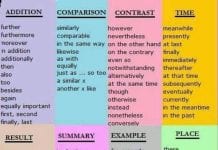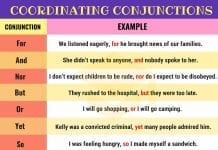
A pronoun is a word that can function as a noun phrase used by itself.
It is used to refer to a person in the discourse i.e. you or I, or to someone or something mentioned elsewhere in the discourse i.e. she, they, it. Pronouns are used in the place of a noun that has already been mentioned or that is already known. We often use pronouns to avoid repeating ourselves.
For example:
Instead of saying
- Kate had worked really hard all day. Kate was very tired, so Kate got into Kate’s bed and fell asleep straight away.
It would be better to say
- Kate had worked really hard all day. She was very tired, so she got into her bed and fell asleep straight away.
There are different types of pronouns; these are listed below:
Personal Pronouns
These are used instead of nouns referring to specific people or things.
For example, I, me, you, mine, we, they, yours, his, hers, them and theirs.
Personal pronouns can be divided into different sub-categories depending on their role in a sentence. These are as follows:
Subjective Pronouns
The personal pronouns I, you, we, they, he, she, and it are known as subjective pronouns because they act as the subjects of verbs.
- They saw Jeremy today.
- We walked Jenny home.
- I helped my neighbour.
Objective Pronouns
The personal pronouns me, you, us, him, her, it and them are called objective pronouns because they act as the objects of verbs and prepositions.
- Jeremy saw them today.
- Jenny walked us home.
- My neighbour helped me.
Here is a table to help you identify the different forms:
| singular | plural | |||
|---|---|---|---|---|
| subjective | objective | subjective | objective | |
| first person | I | ME | WE | US |
| second person | YOU | YOU | YOU | YOU |
| third person | HE/SHE/IT | HIM/HER/IT | THEY | THEM |
It may be worth noting that the pronouns YOU and IT stay the same, whether they are being used in subjective or objective roles.
More for you:
12 (All) English Tenses with Examples
A BIG List of Prefixes and Suffixes and Their Meanings
POSSESSIVE PRONOUNS
The personal pronouns mine, yours, his, hers, theirs, and ours are known as possessive pronouns because they refer to something that is owned by either the speaker or someone or something previously mentioned.
- That pen is mine.
- This house is hers.
- Theirs isn’t as nice as ours.
Possessive pronouns are used to refer to a specific person or thing that belongs to someone or something else. These pronouns are used depending on whether the thing or person in question is singular or plural, in first second or third person, and gender (male or female).
Here is a table and example sentences to help you understand the different forms:
| NUMBER | PERSON | GENDER (of owner) | POSSESSIVE PRONOUN |
|---|---|---|---|
| singular | FIRST | male/female | MINE |
| SECOND | male/female | YOURS | |
| THIRD | male | HIS/WHOSE | |
| female | HERS/WHOSE | ||
| plural | FIRST | male/female | OURS |
| SECOND | male/female | YOURS | |
| THIRD | male/female/neuter | THEIRS/WHOSE |
- These children are mine.
- Those books are yours.
- This responsibility is his.
- All these shoes were hers.
- Are these keys ours?
- I think this t-shirt is yours.
- Our car is ugly. I like theirs better.
- She doesn’t know whose car that is.
- The boy whose bike was stolen, lives over there.
- The family whose house we bought, have moved to France.
More for you:
What are possessive nouns, and how do we use possessive’s?
Punctuation Marks – Quotation Marks – Question Mark

REFLEXIVE PRONOUNS
The personal pronouns myself, yourself, themselves, himself, herself, itself, ourselves, and yourselves are called reflexive pronouns because they refer back to the subject of the clause in which they are used.
- I injured myself yesterday.
- The campers cooked for themselves.
- John learnt how to tie his shoelaces all by himself.
Reflexive pronouns are used when we want to refer back to the subject of a sentence or clause. All the reflexive pronouns end in either -self (singular) or -selves (plural). The word ‘reflexive’ means to reflect back on a subject, like a mirror.
There are eight reflexive pronouns:
Singular: myself, yourself, himself, herself, itself.
Plural: ourselves, yourselves, themselves.
Here are some example sentences:
- I’ve hurt myself.
- Did you clean this house all by yourself?
- He bought a birthday present for himself.
- She looked at herself in the mirror.
- The computer turned itself off automatically.
- We bought some food for ourselves.
- Can you all take care of yourselves while we are away?
- We can’t help them, if they don’t want to help themselves.
More for you:
Questions and Answers to Prepare You for a Job Interview in English
English Vocabulary for IELTS Speaking Test (Everything You Need)
DEMONSTRATIVE PRONOUNS
These are used to represent a thing or things. If it is near in distance or time then you use these or this. If it is far in distance or time, you use those or that. The word ‘demonstrative’ derives from ‘demonstrate’ which means to show, indicate or point to something. This would be an easy way of remembering this type of pronoun.
Here is a table and example sentences to help you identify the forms:
| near | far | |
|---|---|---|
| singular | THIS | THAT |
| plural | THESE | THOSE |
- This tastes delicious!
- Is this pen yours?
- Catch that thief over there!
- Is that your plan for next week?
- These paintings are beautiful!
- Are all these children yours?
- How much are those dresses over there?
- Could you give me those boxes please?
More for you:
Essential Academic Writing Examples and Phrases!
When to Use THIS (THESE) and THAT (THOSE) in English!
INTERROGATIVE PRONOUNS
We use interrogative pronouns to ask questions. ‘Interrogative’ derives from the word ‘interrogate’, which means to ask questions. These pronouns represent the thing that we don’t know, in other words, what we are asking the question about.
There are four main interrogative pronouns, these are whom, who, which, and what. Whose is a possessive interrogative determiner – the only one in the English language. This means it can be used as a possessive pronoun and an interrogative pronoun.
Here is a table and example sentences to show you how these are used:
| subject | object | ||
|---|---|---|---|
| person | WHO | WHOM | |
| thing | WHAT | ||
| person/thing | WHICH | ||
| person | WHOSE | <<= (POSSESSIVE) |
Remember that WHOM is the correct form when the pronoun is the object of the verb. This pronoun is rarely used in spoken or written English. Native speakers would say WHO instead of WHOM.
- Whom did you speak to?
- I spoke to Sarah.
- Who gave that to you?
- Jenny gave it to me.
- What would you like to do?
- I would like to go on a holiday.
- Which dress do you like?
- I like the purple one.
- Whose car is this?
- It is John’s car.
More for you:
Who vs Whom. A Simple Explanation for determining when to use …
WHAT or WHICH!
RECIPROCAL PRONOUNS
Reciprocal pronouns are used when each of two or more subjects are acting in the same way towards each other. For example, person 1 is studying with person 2 and person 2 is studying with person 1. So, person 1 and person 2 are studying with each other. The word ‘reciprocal’ derives from ‘reciprocate’, which means to do or give in return, or express mutual action.
There are only two reciprocal pronouns, so very easy to remember! They are:
each other
one another
In order to use these correctly, the subjects must be doing the same thing, and there must be two or more people, groups, or things involved, because you cannot use reciprocal pronouns with I, me, you, he, she or it.
Here are some examples:
- We have to help one another.
- You can see that they love each other very much.
- How do you two know each other?
- They always seem to blame one another for all their problems.
More for you:
Difference Between EACH OTHER and ONE ANOTHER!
How to Express Good Wishes Using MAY?
INDEFINITE PRONOUNS
Indefinite pronouns do not refer to one particular person, amount or thing. They are vague and not definite, hence the title ‘indefinite’!
Some examples of the most common indefinite pronouns are:
All, another, somebody, someone, everybody, everyone, no one, nobody, anybody, anyone, each, anything, several, something, nothing, none, one, each, few, many, some, any.
Many indefinite pronouns have other roles too, and can function as different parts of speech. Most of these would be either singular or plural, but sometimes they could be singular in one context and plural in another! Remember that a singular pronoun would link to a singular verb, and they must agree in number and gender.
Here are some example sentences:
- Have you eaten anything since I last saw you?
- I keep trying to tell them, but nobody believes me!
- Can someone answer the phone please!
- Have the others tried to contact him?
- There are a few cakes left.
More for you:
What’s the difference between somebody, someone, anybody, anyone …
How To Use The Passive Voice With Helpful Examples
RELATIVE PRONOUNS
A relative pronoun introduces a relative clause. It is a called a ‘relative’ pronoun because it ‘relates’ to the word that is being modified by its clause. There are five relative pronouns, they are – who, whom, whose, which, and that.
Who (subject) and whom (object) are used for people only.
Whose is used for possession.
Which and that are used for things.
All these relative pronouns can refer to singular or plural and it doesn’t matter whether the subject is male or female. Note: That can be used for people as well, but only in a defining relative clause, meaning a clause that is essential to the sentence and isn’t just providing extra information.
Here are some examples:
- The car that I drive is very old.
- Jane, whom I saw yesterday, is getting married.
- The person that I was talking to last night is my boyfriend.
- The phone that I sold, wasn’t working very well.
- My grandmother, who is very ill, needs someone to take care of her.
- The car, which was given to me, has broken down.
- I know the family, whose dog this is.
More for you:
Formal and Informal Email Phrases – from Greetings to Closing Phrases!
6 Ways to Immediately Improve Your English Communication Skills





![Names of Generations, Years and their Characteristics [Generations Timeline] Names of Generations and years: The Greatest Gen, Baby Boomers, Gen X, Y, Z](https://www.myenglishteacher.eu/blog/wp-content/uploads/2020/06/Names-of-Generations-218x150.png)




















